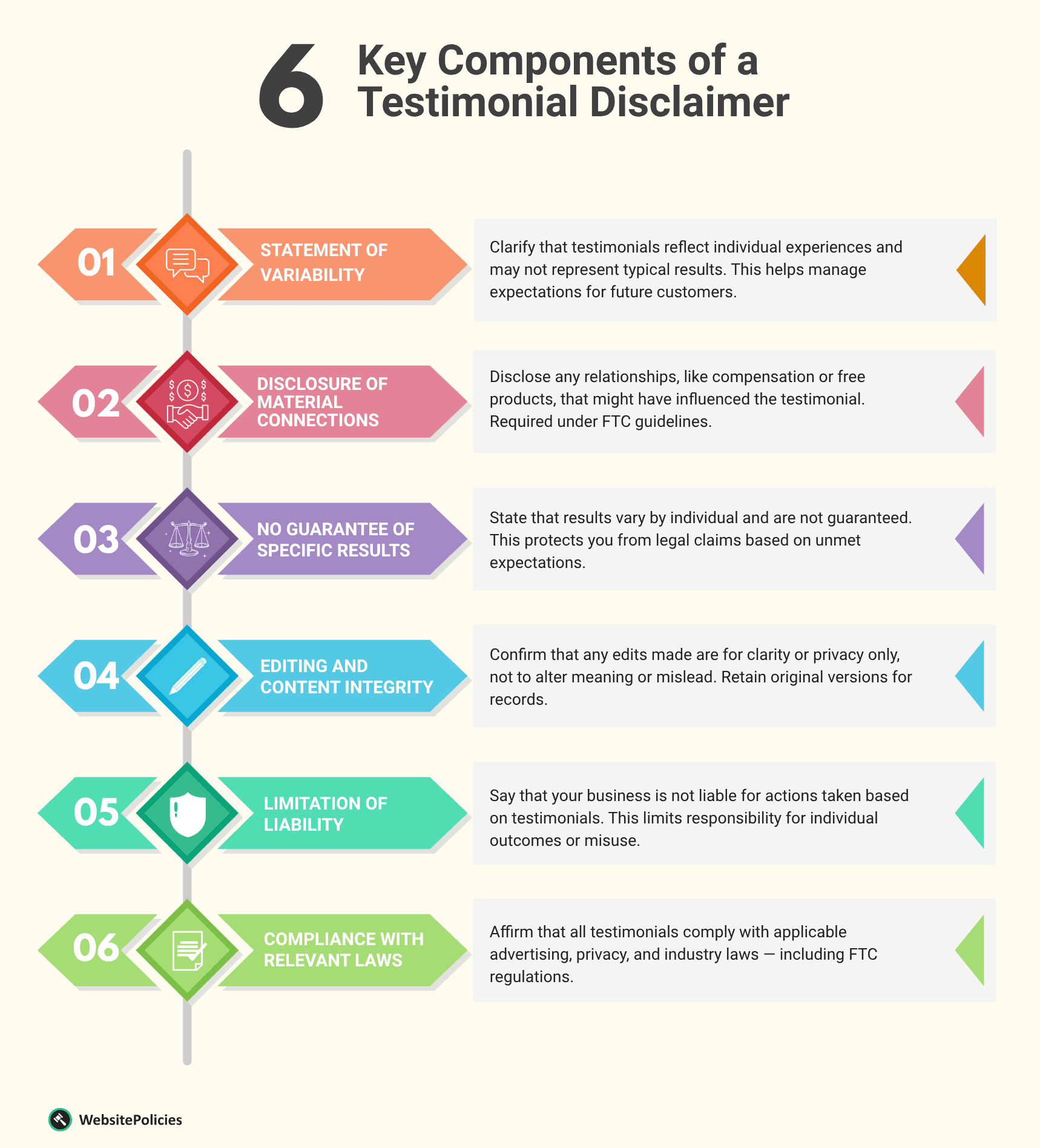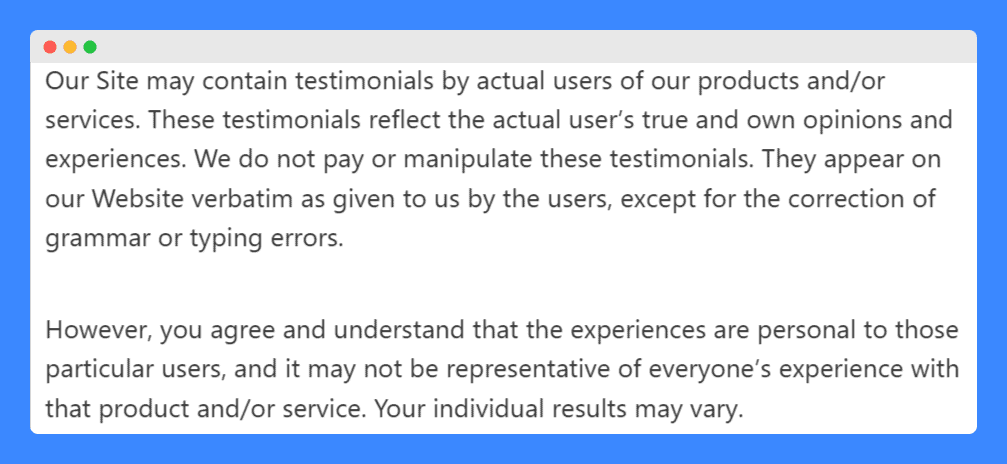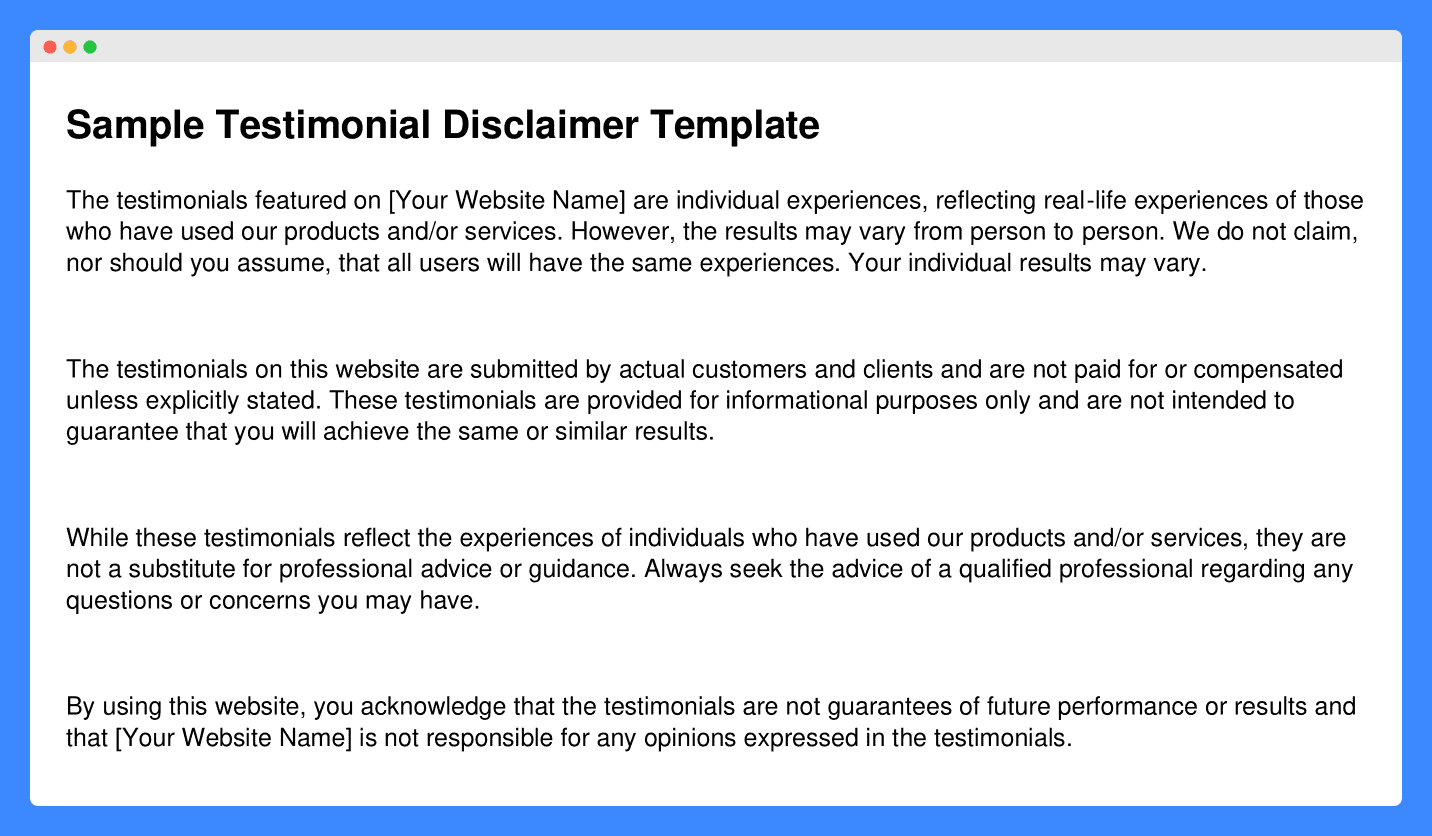It’s undeniable that customer testimonials can build trust and credibility for your business. When potential customers read glowing reviews about your business, they become more confident about buying a product or service from you.
That said, it’s also important that you remain transparent about the limitations of these testimonials. This is where you’ll need a testimonial disclaimer.
A testimonial disclaimer is a statement that clarifies the individual nature of the experiences shared. In turn, customers understand that results may vary and that the testimonials don’t guarantee similar outcomes for everyone.
Below, we’ll explore the key elements of creating a testimonial disclaimer that clearly communicates expectations and aligns with legal standards.
- Make sure your testimonial disclaimer is visible. If it’s buried, it might as well not be there.
- Regularly update your disclaimer to keep it aligned with the latest legal standards.
- Be transparent about edits and incentives. Your customers value honesty.
Table of Contents
PRO TIP: Take the hassle of writing your own disclaimer away with our disclaimer generator trusted by over 200,000 businesses. It’ll save you hours of work and possible costly legal mistakes.
Types of Testimonial Disclaimer
To strengthen the credibility of the testimonials published on your website, your disclaimer must align with your business needs. Here are the most common types you should consider using:
Results May Vary Disclaimer
This type of disclaimer clarifies that the experiences or outcomes showcased in testimonials are specific to those individuals.
Basically, it emphasizes that individual results may vary depending on a variety of factors like personal commitment, starting point, and personal circumstances.
By including this disclaimer, businesses help set realistic expectations and reduce the risk of misunderstandings among consumers.
Patient Testimonials Disclaimer
This type of disclaimer informs readers that testimonials are not necessarily representative of what anyone else using the treatments or products will experience.
It is the recommended disclaimer style for businesses and companies in the healthcare sector, where reviews can influence patient expectations about the effectiveness of treatments or products.
Through this disclaimer, you can also say that the testimonials do not claim that the products can diagnose, treat, cure, or prevent any disease.
No Guarantee of Results Disclaimer
A No Guarantee of Results Disclaimer explicitly states that there is no guarantee that customers will achieve the same results as those featured in the testimonials.
Unlike the Results May Vary Disclaimer, which acknowledges that individual results can differ, this disclaimer outright denies any guarantee of specific outcomes. As such, it often goes something like,
“The reviews or testimonials appearing on this site do not guarantee identical results for everyone else. Individual factors and circumstances may influence results.”
Product Review Disclaimer
Businesses use this type of disclaimer to clarify that the testimonials displayed on a website or marketing materials represent the personal opinions and experiences of those who have used the product, rather than objective facts or broadly applicable results.
To give you an example, think of a company selling ergonomic office chairs. The product review disclaimer would be useful here.
You can use it to inform potential buyers that while some testimonials may praise the chair for comfort, these experiences might not reflect every user’s outcome due to differences in individual body types, sitting habits, or workplace environments.
Paid Endorsement Disclaimer
This testimonial disclaimer type discloses any compensation that might have influenced the testimonials or endorsements presented.
Yes, this includes cases where endorsers (or paid actors, as some might call them) received free products or services in exchange for their review.
According to the FTC, any material connection between an endorser and the company (like receiving compensation or free products in exchange for a review) must be disclosed. Failing to comply can lead to legal repercussions.
Typical Results Disclaimer
This type of disclaimer clarifies that the testimonials or user stories shared may not reflect the most common customer experience.
Unlike the Results May Vary, which highlights the variability of potential outcomes, this one specifically sets expectations about what most users can realistically expect.
For example, a fitness program might feature a testimonial from a user who lost an unusually high amount of weight. A Typical Results Disclaimer would help clarify that these results, while impressive, are not necessarily what most participants achieve.
Editing Disclaimer
There are times when a business needs to clarify that testimonials may have been edited for clarity, brevity, or grammatical correctness. For this, they use an Editing Disclaimer.
The statement usually specifies that the testimonials are given verbatim except in these specific circumstances. This disclaimer would also cover edits made to remove personally identifiable information to protect privacy.
For instance, in cases where the original testimonial included extraneous information, or suffered from grammatical or typing errors, you might edit these out to enhance clarity and impact without altering the message’s intent.
Who Needs a Testimonial Disclaimer?
Businesses that showcase customer feedback must disclose the context. This is crucial especially if the reviewer received the product or service for free. It could be in any industry, but here are some examples:
Health and Wellness
Companies in this sector often use patient success stories to promote supplements, diets, or exercise programs. A disclaimer is needed to clarify that results vary and are not guaranteed.
Financial Services
Financial advisors and investment platforms use client testimonials to illustrate potential gains. Disclaimers are essential to communicate that past performance does not guarantee future results.
Educational Services
Educational tools and courses might showcase student testimonials to indicate potential learning outcomes. A disclaimer ensures prospective students understand that results can differ based on individual effort and circumstances.
Beauty and Personal Care
This industry often features dramatic before and after photos or user testimonials about product effectiveness. Disclaimers are needed to indicate that results may not be typical for all users.
Tech Products and Apps
Technology companies, especially those offering software or apps, use customer testimonials to highlight their product’s efficacy. A disclaimer clarifies that user experiences can vary significantly based on usage patterns and compatibility.
Why Do You Need a Testimonial Disclaimer for Your Website?
You need a testimonial disclaimer on your website to manage customer expectations and maintain legal compliance.
If you feature testimonials, please be aware of the following:
- The Fair Trade Commission Act enforces that testimonials comply with truth-in-advertising standards.
- The United States Copyright Act requires that testimonials be used with the proper permissions and do not violate copyright norms.
- The Consumer Protection from Unfair Trading Regulations Act protects against deceptive marketing practices that could mislead consumers.
- The California Online Privacy Protection Act requires transparency about how personal data (including testimonials) is collected and used.
Additionally, disclosing the relationship between endorsers and the product/service is in accordance with the FTC Guidelines Concerning the Use of Endorsements and Testimonials in Advertising.
6 Key Components of a Testimonial Disclaimer
Include these essential elements in your customer testimonial disclaimer to make sure it’s both effective and compliant with legal standards:

1. Statement of Variability
Through this statement, you’re able to clarify that testimonials and endorsements reflect real-life experiences of individuals. Hence, they may not be universally applicable or typical for everyone.
Here’s how Chews Food Wisely, a dietary supplement company, made that clear in its Testimonial Disclaimer.

This language helps ensure that while the testimonials reflect genuine experience, potential customers know they might not achieve the same results.
2. Disclosure of Material Connections
In the US, businesses are required to reveal any relationships that might influence the testimonials or reviews. This includes situations where reviewers received compensation or free products in exchange for their endorsement.
For example, an online skincare company may have sent free product samples to beauty bloggers in exchange for reviews. The company’s testimonial page should clearly state,
“The individuals who provide a testimonial or review on this site may have received compensation in the form of free products. This may have influenced their testimonial, and we disclose this in accordance with FTC guidelines concerning use of endorsements.”
PRO TIP: This part of the disclaimer should also cover anyone with a vested interest in your company who has been asked to provide a testimonial or review.
3. No Guarantee of Specific Results
This section of a testimonial disclaimer states that the outcomes depicted in testimonials are not guaranteed to be the same for every user.
Here’s an example of a testimonial disclaimer from Jenny J Fitness that stresses individual results and results do vary:

This type of disclaimer not only helps maintain ethical transparency but also guards against potential legal claims by dissatisfied customers who may not achieve the same results as those featured in testimonials.
4. Editing and Content Integrity
Adding this bit ensures that any alterations made to testimonials do not misrepresent or distort the message of the endorsers.
It specifically addresses concerns about the ethical handling and manipulation of these works. It states that edits for grammar, clarity, or brevity are permissible, but not if they change the overall impression or intent of the testimonial.
For example, a cosmetic brand using a before-and-after photo testimonial in a social media post might include a disclaimer stating,
“The testimonials displayed on our website are edited only for privacy and clarity. No manipulation of these works has been done to alter the effectiveness of the product depicted. All images represent the honest opinions and results of our users.”
PRO TIP: Keep original copies of all testimonials and endorsements for legal protection and verification purposes.
5. Limitation of Liability
Disclaimers may help reduce the liability of a company by stating that testimonials and recommendations should not be seen as guarantees for future performance or results.
Using this clause, you effectively communicate that your business cannot be held responsible for any actions taken by the customer based on the information provided in the testimonials.
Here’s a good example from Antjies:

This seller of bath products made sure it’s drafted comprehensively to cover various aspects of customer interaction. This not only included results or efficacy but also extended to any potential misuse of products based on testimonial content.
6. Compliance with Relevant Laws
A customer would be interested in knowing that a company not only promotes its products but does so in a manner that is legally compliant and respectful of consumer rights.
So, in this part of the disclaimer, remind users that all testimonials, endorsements, and testimonial review examples meet legal standards set by regulatory bodies.
This includes adhering to truth-in-advertising laws, privacy regulations, and any specific industry standards. You can say,
“All testimonials featured have been used in accordance with laws governing the use of endorsements. We ensure all our testimonials comply with the FTC’s guidelines and respect the privacy of our endorsers.”
PRO TIP: Perform regular audits by legal professionals to help maintain this compliance and avoid potential legal issues.
How Do You Write a Testimonial Disclaimer for Your Business?
Writing a testimonial disclaimer involves understanding the specific legal terms relevant to your industry and tailoring the content to your business’s unique offerings and customer experiences. Once that’s covered, follow these steps:
Step 1: Identify the Purpose
Understand why you are including a testimonial disclaimer (e.g., to manage expectations or disclose material connections).
Step 2: Review Applicable Laws
Research the legal terms and regulations that govern the use of testimonials in your industry and region.
Step 3: Draft the Key Components
Incorporate all necessary elements such as the statement of variability, no guarantee of results, and compliance with laws.
Step 4: Use Clear and Conspicuous Language
Ensure the disclaimer is written in plain language that your customers can easily understand.
PRO TIP: For businesses without legal expertise, consider using a disclaimer generator that helps create legally compliant disclaimers tailored to your specific needs.
Where To Display a Testimonial Disclaimer
Display a testimonial disclaimer prominently so that all users, regardless of where they engage with your content, are aware of the nature of your testimonials. Here are some of the best spots:
- Website or App: Include the disclaimer on the same page where the testimonials are shown, or on a dedicated testimonials page, ensuring it’s visible without needing to scroll.
- Terms and Conditions: Embed the testimonial disclaimer within your Terms and Conditions Agreement, especially if this document is readily accessible to users at sign-up or during purchases.
- Social Media: When posting testimonials on social media platforms, either include a brief version of the disclaimer in the post or link to a page on your website where the detailed disclaimer can be read.
- Marketing Materials: For printed or digital marketing materials that feature testimonials, ensure the disclaimer is clearly visible or referenced with a direct link to the full text.
- Footer of Emails: Include a brief disclaimer or a link to the disclaimer in the footer of marketing emails that contain customer testimonials.
Testimonial Disclaimer Examples You Can Learn From
Now that we’ve covered the basics, let’s look at some real-world examples. These will give you practical insights into how different business effectively implement their testimonial disclaimers:
1. The Transform App
In the health and wellness sector, it’s important to manage user expectations regarding health outcomes. The Transform App does this effectively on its dedicated testimonial disclaimer page:

Here, The Transform App provides a comprehensive explanation of how it handles testimonials in line with FTC guidelines. It clearly communicates the variability of potential results and the importance of following program guidelines for success.
2. CFO on Speed Dial
CFO on Speed Dial is a consulting service that provides expert financial advice and strategic planning support, typically serving small to medium-sized businesses looking to optimize their financial management.
Here’s how it shows transparency about client experiences:

This testimonial disclaimer sample is an excellent illustration of how a financial services company can acknowledge that individual outcomes can vary. Plus, the careful wording protects both the service provider and the clients.
3. Market Traders
Market Traders is an educational platform specializing in teaching trading skills and strategies. Its approach to disclaimer for testimonials is exemplary for learning platforms:

Using simple language, it’s able to communicate that while the testimonials are real, they do not guarantee that all users will achieve the same levels of success.
4. Colored Hair Care
Colored Hair Care is a popular online store specializing in hair care products for color-treated hair. The disclaimer section on the website serves as an excellent example of a personal care website:

It transparently states that the testimonials are from real users who have not been compensated or influenced to share overly positive views. Importantly, the testimonials are presented verbatim, with only grammatical or typographical errors corrected.
5. Beat the Dad Bod App
The Beat the Dad Bod App aims to motivate and support fathers to maintain a healthy lifestyle despite their busy schedules and familial responsibilities.
The way it uses its testimonial disclaimer sets a great example for other apps in the health and fitness industry.

By stating they do not verify the accuracy or authenticity of the testimonials and clarifying that these are subjective opinions, the app distances itself legally from potential claims of misleading advertising.
This responsible approach enhances user trust and aligns with best practices for transparency in promotional strategies.
Sample Testimonial Disclaimer Template
This testimonial disclaimer template offers a foundational structure for creating your own disclaimer for your website. While it includes the core elements, it’s essential to adjust and personalize the content to meet your specific needs and comply with any relevant legal obligations.

Frequently Asked Questions
Do I need a disclaimer for every testimonial on my site?
No, you don’t need a disclaimer for each testimonial. One clearly visible disclaimer on your site is sufficient.
Can I include a testimonial disclaimer in video testimonials?
Yes, you can include a disclaimer in a testimonial video. Display it at the beginning or end to guarantee visibility.
Should I include a testimonial disclaimer in my email marketing campaigns?
Yes, include a testimonial disclaimer in email campaigns. Similar to using testimonial disclaimers on your website, it ensures consistency and transparency.
How often should I review and update my testimonial disclaimer?
Review and update your testimonial disclaimer annually, or whenever you make significant changes to your website or application.
How can I ensure my testimonial disclaimer is compliant with FTC guidelines?
Ensure compliance by regularly reviewing FTC guidelines and incorporating the appropriate disclaimer in your marketing materials. Consult with a legal expert for accuracy.



